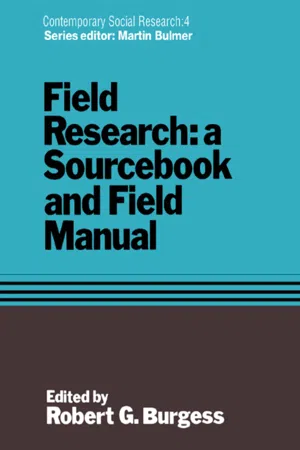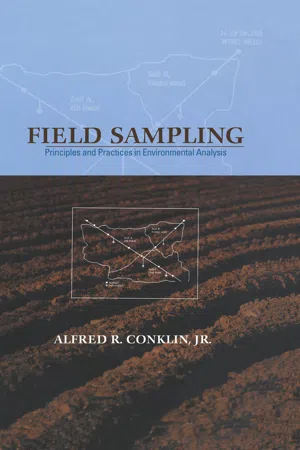Geography
Sampling Techniques
Sampling techniques in geography refer to the methods used to select a representative subset of a larger population for study or analysis. Common techniques include random sampling, stratified sampling, and systematic sampling. These methods help ensure that the sample accurately reflects the characteristics of the larger population, allowing geographers to make inferences and draw conclusions based on the sample data.
Written by Perlego with AI-assistance
Related key terms
10 Key excerpts on "Sampling Techniques"
- eBook - ePub
- Li-Chun Zhang, Raymond L. Chambers(Authors)
- 2019(Publication Date)
- Chapman and Hall/CRC(Publisher)
Spatial statistics includes many techniques to study spatial phenomena, based on different analytic approaches and applied in many different fields, such as ecology, economics, epidemiology, image analysis and more [ 23, 25, 50, 54 ]. One of the contexts in which spatial aspects of units are very important is sampling theory. Here, the knowledge about locations of population units in a geographic space can be very helpful in studying phenomena characterised by spatial dependence and heterogeneity [ 2, 3 ]. Spatial sampling is a prosperous field of research that in recent years has produced several new methodologies. Basic sampling schemes include random, clustered and systematic methods, which take into account spatial information in the phase of sampling design. These methods can be applied according to different resolutions of the spatial information (i.e., cities, urban areas, neighbourhoods, regions) where the finest level consists of the individual point locations of the units, as identified by the spatial coordinates (namely longitude and latitude). Geographic coordinates are identified from information collected through Geographical Information Systems (GIS), which obtain, register, analyse and visualize geo-referenced data [ 13 ]. Moreover, the availability of spatial information about units leads to their use as an important auxiliary variable, which could be used as a strong informational component in, among others, stratification and estimation procedures. As said before, spatial sampling could have several applications in agriculture, environmental studies and, more in general, social science [11, 21, 28, 30, 44, among others]. In this chapter, we focus the attention on geo-referenced administrative data, such as, in particular, population and business registers in Italy - Richard Harris, Claire Jarvis(Authors)
- 2014(Publication Date)
- Routledge(Publisher)
target population can be defined as the complete set of measurements that might hypothetically be recorded in a particular study context that are relevant to the study. In a geographical context this could include for example all people or vegetation within a defined area at a certain time, or the distributed activities of a single business unit operating from one location. Often, the notion of population is more theoretical than quantifiable.A population falling outside either the geographical area or context of a study is sometimes referred to as an out-of-scope population .The characteristics of a sample of a population are known as statistics. The nature of the population and its mathematical relationship to the sample will be discussed further in Chapter 5 . In Chapter 5 , too, specific mathematical notation concerning the sample and population will be introduced.A sample that matches (or represents) the population is known as a representative sample . Achieving a representative sample is a key issue when adopting probabilistic statistical methods in your research, but also applies when adopting other geographical methodologies whether qualitative or quantitative in approach. However, not all research traditions require that the outcomes are representative of the whole, as some work is illustrative in nature. It is important to respect these differences across the discipline; there is a place for the in-depth case study, particularly in regard to gaining more detailed knowledge about how a process or phenomenon emerges. This caveat applies in both human and physical geography.Key concept 4.2 Representative sampleThis is a sample that matches (or represents) the statistical characteristics of the overall target population. The characteristics of a sample are known as its statistics.The stages of the sampling process are outlined within Figure 4.1- eBook - ePub
Research Design in Social Work
Qualitative and Quantitative Methods
- Anne Campbell, Brian J. Taylor, Anne McGlade(Authors)
- 2016(Publication Date)
- Learning Matters(Publisher)
3 : Sampling Techniques in Quantitative and Qualitative ResearchChapter Aims
This chapter will:- consider a range of Sampling Techniques and their relevance to a selection of research designs;
- examine the differences between probability and non-probability Sampling Techniques;
- discuss a range of probability sampling methods including simple, systematic, stratified, random and cluster sampling;
- consider non-probability designs, for example purposive, quota and snowball Sampling Techniques.
Introduction
Sampling is a core component of any research project but, unfortunately, it is one that is often misunderstood or misinterpreted by social work undergraduate and postgraduate students as they grapple with the new language and foreign concepts associated with the research process.However, as a social work research student you must have an understanding of the various types and uses of Sampling Techniques in order to ensure that your research project is viable and fit for the purpose for which it was designed. There are a number of questions which must be considered before choosing a suitable sampling technique including:- What is the difference between probability and non-probability sampling?
- Which do I use and why?
- How big does the sample need to be?
- Is it important to have a representative sample?
- Which one of the many Sampling Techniques is most suited my intended research design?
In some research projects, researchers opt for a census approach whereby all members of the population are used in the study. The population is the entire group of people or units that the researcher wishes to study. For example, you may wish to seek the views of all first year social work degree students (n = 300) in the two universities in Northern Ireland. It is possible to use a census method - eBook - ePub
Research Methods for Students, Academics and Professionals
Information Management and Systems
- Kirsty Williamson(Author)
- 2002(Publication Date)
- Chandos Publishing(Publisher)
Section 3 TechniquesPassage contains an image
Introduction
The third section, Chapters 13 to 16 , describes techniques used for data collection. Techniques are defined as the means by which data are gathered and samples selected. Techniques discussed in this section include questionnaire design, interviewing, focus groups and ethnographic techniques, including participant observation.Passage contains an image
Chapter 13Research techniques: Sampling
Kirsty WilliamsonObjectives At the end of this chapter you will be able to:• define the terms used to describe sampling and samples;• describe different types of sampling;• understand the concept of random sampling;• understand how decisions about the type of sample to be used should be matched to the purpose of the research and the specific research questions to be investigated; and• understand the limitations of non-probability samples, especially in relation to generalisations.Introduction
This chapter is the first in a series of chapters intended to introduce you to a range of different techniques which are used in research. The approach used here is somewhat different from that used by most writers of ‘research methods’ texts, who usually deal with ‘techniques’ as an integral part of specific methods. The rationale for taking the approach of introducing techniques separately from methods, is that most of the techniques can be used in more than one method. For example, sampling is relevant to almost all research methods.Since an important goal of this book is to assist you to be critical users of research, there is an emphasis on the salient points to notice when evaluating how well a technique has been used. In the case of sampling the term ‘random sampling’ is probably the most misused in the research literature. It is very important that you understand the definition of random sampling and that you are also able to judge when researchers have understood and applied it correctly. It is also important to understand when results can be generalised and when they cannot (which is related to sampling) and to understand the terminology of sampling, for example, how a population differs from a sample - eBook - ePub
Dissertation Research Methods
A Step-by-Step Guide to Writing Up Your Research in the Social Sciences
- Philip Adu, D. Anthony Miles(Authors)
- 2023(Publication Date)
- Routledge(Publisher)
The practice of sampling can be used to make an inference about a population or to make a generalization in relation to an existing theory. This is based on the choice of sampling technique.The practice of evaluating the characteristics of an entire population through a representative sample can be an arduous endeavor. As with many research studies, the best strategy to investigate a problem in an entire population is through the use of sampling. How, it is not always possible to conduct a study on an entire population. So, we use the practice of sampling. Thus, the researcher studies a sample of the population, which is a suitable representation of the entire population. We must think of a sample as a subset of the population; thus it is selected to be representative of the population. Again, one of the advantages of sampling is that it can be less costly and more efficient. Being able to use a sample to generalize the results to a whole population requires the use of one of the statistical sampling methods for evaluation. Taking a subset from a chosen sampling frame or entire population is the basic practice of sampling.There are many types of Sampling Techniques. However, there are two basic types: (a) probability or random sampling; and (b) non-probability sampling. Before choosing a specific type of sampling technique, a broad sampling technique needs to be decided on. Figure 16.2 shows the various types of Sampling Techniques (Acharya et al., 2013 ; Taherdoost, 2016 ).Figure 16.2Types of Sampling Techniques.Probability Sampling
The definition of probability sampling is that every item in the population has an equal chance of being included in the sample. The key is, if all participants are equally likely to be selected in the study, equiprobability sampling is being used. The odds of being selected by the research team may be expressed by the formula: P=1/N, where P equals the probability of taking part in the study and N corresponds to the size of the target population (Martínez-Mesa et al., 2016 ).An interesting aspect of probability sampling methods is that they share three properties. First, the sampling units’ selection process is random. Second, each potential sampling unit has a known probability of being selected for the sample, which is different from zero. Lastly, it is possible to identify all potential samples of a given size that can be drawn from the population before the actual selection process starts (Sarstedt et al., 2017 ). In the context of probability sampling, all units of the target population have a nonzero probability of taking part in the study. Probability sampling is the most favored form of sampling by the research community. In this method, there are five primary sampling designs that are preferred for accurate, unbiased sampling (Nanjundeswaraswamy & Divakar, 2021 - eBook - ePub
Understanding Research for Business Students
A Complete Student′s Guide
- Jonathan Wilson(Author)
- 2021(Publication Date)
- SAGE Publications Ltd(Publisher)
Subsequently, we look at how sampling methods are applied in practice. You can also learn about how to apply sampling methods by reading past dissertations and journal articles. Irrespective of the topic, it is interesting to see ‘how’ and ‘why’ researchers have chosen certain sampling methods. This may help you to consider how to apply methods within your own study. The chapter then moves on to explain and give examples of multiple sampling methods. Lastly, we look at how sampling methods relate to other steps in the research process.As you can see by Figure 9.1 , we have arrived at ‘Sampling Techniques’ in The Research Wheel. This forms part of the ‘Planning stage’ in your research journey. Why? Well, it is essential to plan how you identify your potential research participants. Rather than simply aiming for a certain number of responses, your chosen sampling method(s) is based on a number of factors. This includes your research questions and methodological approach. For example, adopting a qualitative strategy means the likelihood is that you will have a small sample size. Hence, your chosen sampling method will reflect this.A key part of doing research is understanding how your choice of sampling method(s) will work in practice. ‘Sampling Techniques’ is the final step in the ‘Planning stage’ in The Research Wheel. Now that your planning is done, it is time to go through the ‘Action’ stage in your research. The first step – secondary data – is something we examine in the next chapter .Figure 9.1 The Research WheelWhat is a sample?
Prior to examining the steps in the sampling process, it is important for you to understand how to define the key terms associated with sampling. First, a sample can be defined as a sub-set of the population, while sampling means selecting a suitable sample for research. The term ‘population’ refers to a clearly defined group of cases in which the researcher can draw. Sampling can be used to make inferences about a population or to make generalizations in relation to existing theory. Figure 9.2 - eBook - ePub
Essential Environmental Science
Methods and Techniques
- Simon Watts, Simon Watts(Authors)
- 2003(Publication Date)
- Routledge(Publisher)
All that has been said about the desirability of random samples in the social environmental sciences applies equally to sampling in the physical environmental sciences. The difference is that, because of the nature of the physical system, random samples are very difficult to obtain (if possible at all). The following sections discuss the kinds of sampling frameworks available in the physical environmental sciences.see Section 2.22.3a Sampling in areas
Phenomena studied in the environmental sciences are often not accessible, individual ‘things’ which can be numbered and subjected to an ordinary probability sampling procedure. Geologists are perhaps in the worst position of all, as their subject matter is almost all buried at depth and they must take whatever evidence they can from outcrops or drill holes that happen to be available. Under these conditions it is very difficult to demonstrate that a sample is unbiased. In some branches of the environmental sciences populations are more accessible (like plants and animals), but the problem often is that they do not consist of identifiable and separate objects. Air, water, soil and rock are continuous media, and variables like air temperature, soil depth and water salinity are spread continuously. For this type of variable, location is often used as the basis of the sampling procedure. Consequently, measurements are taken at particular points, along lines or traverses, or in small areas (quadrats) (see Fig. 2.1 ).There are several methods for deciding the location of your sample points, traverses and quadrats. Here we shall describe the most commonly used methods for deciding the location of sampling points. The principles apply also to traverse and quadrat sampling. Fig. 2.2 illustrates the sampling designs.The methodology of simple random sample selection is given in Box 2.2 - eBook - ePub
Field Research
A Sourcebook and Field Manual
- Robert G. Burgess(Author)
- 2003(Publication Date)
- Routledge(Publisher)
Sampling Strategies in Field ResearchPassage contains an image
11Elements of Sampling in Field Research
ROBERT G.BURGESSSampling is traditionally associated with survey research, yet it is an essential element of all social investigation. It is a means by which a selection is made from the basic unit of study. Clearly, in any population or in any social setting it is impossible to observe or interview everyone and everything. In these circumstances, a sample is used for detailed study. The methodological literature makes a distinction between various types of sampling and it is to these that we now turn. In terms of statistical sampling the basic distinction that is made is between probability and non-probability sampling. Chein has distinguished these forms of sampling in the following terms: ‘The essential characteristic of probability sampling is that one can specify for each element of the population the probability that it will be included in the sample’ (Chein, 1976, p. 516). While: ‘In non-probability sampling, there is no way of estimating the probability that each element has of being included in the sample and no assurance that every element has some chance of being included’ (Chein, 1976, p. 516; emphasis in original).In these terms probability sampling includes: simple random sampling, stratified random sampling, cluster sampling, multi-stage sampling and stratified cluster sampling, all of which are discussed in some detail by Moser and Kalton (1971). Non-probability sampling includes: accidental samples, quota samples, judgement samples and snowball samples, all of which are discussed in less detail in the basic methodology texts. A common error has been to equate sampling with survey research and to assume that field research does not involve any form of sampling. Such a position oversimplifies the situation. First, field research, especially in urban and rural localities, has involved surveys of the population which have utilised some form of probability sampling (Stacey, 1960; Stacey et al., 1975; Pons, 1969). Secondly, field researchers employ non-probability sampling in their studies when they select research sites and informants, although it is rare for researchers to provide accounts of the criteria that were employed in such non-probability sampling. However, Honigmann (Chapter 12 - eBook - ePub
Nursing Research
An Introduction
- Pam Moule, Helen Aveyard, Margaret Goodman(Authors)
- 2016(Publication Date)
- SAGE Publications Ltd(Publisher)
Network or snowball sampling is the approach used when nurse researchers are aiming to select hidden samples. The researcher will need to draw on networks to identify the sample, often involving a third party in sample access. For example, researchers aiming to recruit the homeless, victims of abuse or other hidden populations may access some participants through hostels or self-help groups, using convenience-sampling methods. They then rely on the initial sample to draw on their networks to recruit further participants. Burns et al. (2014) warn that such Sampling Techniques, whilst recruiting subjects with the knowledge and expertise to provide information for the study, have inherent biases because selection is not independent, as members of the sample are known to one another. Therefore, whilst the researcher bias can be reduced, there is the high potential for sample bias being introduced. However, the approach is often the only one available to researchers sampling populations who are less accessible.Chapter Summary
- An appropriate sample size and composition is crucial to strengthening the research outcomes and conclusion drawing.
- Nurse researchers will often set specific parameters, limiting the study population through the use of inclusion or eligibility criteria.
- A sample is a subset of the population, selected through Sampling Techniques.
- A number of sampling strategies exist for use in both qualitative, quantitative or mixed-methods research that fall within probability and non-probability-Sampling Techniques.
- A sampling frame and specific sample size calculation can be used to support probability sampling for quantitative research.
- Probability sampling is characterised by the use of random selection to obtain sample members.
- There are four commonly used probability-sampling approaches: simple random sampling, systematic random sampling, stratified random sampling and cluster sampling.
- Non-random methods are used to select elements for inclusion in non-probability sampling as qualitative researchers are concerned with gaining understanding, experience and meaning from the most appropriate sample.
- The main methods of sampling used include convenience or accidental, quota and purposive sampling. Samples can also be described as being generated through network or snowball techniques.
Suggested Further Reading
Field, L., Pruchno, R., Bewley, J., Lemay, E.P., Jr. and Levinsky, N. (2006) ‘Using probability vs. nonprobability sampling to identify hard-to-access participants for health-related research: Costs and contrasts’, Journal of Aging and Health - eBook - ePub
Field Sampling
Principles and Practices in Environmental Analysis
- Alfred R. Conklin, Jr.(Authors)
- 2017(Publication Date)
- CRC Press(Publisher)
The sample thus obtained is subjected to laboratory analysis. Both methods are valuable and sometimes essential in field sampling. Both have limitations, and the best sampling results are obtained when all ways of investigating the medium of concern are used. In all cases knowing the location of sampling activities is essential. Determining the location is best done using a global positioning system (GPS). Because of its importance, GPS will be discussed before examining either noninvasive or invasive sampling.In many cases noninvasive sampling is done before invasive or physical samples are taken, mainly because these methods show surface and subsurface features affecting the invasive sampling pattern. In some cases these methods are necessary for the safety of sampling personnel and buried utilities. They will thus be used to develop the invasive sampling plan. Because they will be used first they will be discussed before discussing actual invasive sampling.Data obtained by all sampling methods can be combined in a geographical information system (GIS). Combining data allows them to be both stored and displayed on maps of the area of interest (e.g., thematic maps). As many or as few data as needed can be displayed at one time. Additionally, a GIS system can relate data obtained from sampling to data obtained from other sources, such as aerial maps and soil surveys.5.1 General Sampling Considerations
Analytical and instrumental methods of analysis are very precise and accurate, but the results of analyses of environmental samples are not. This means that the variability comes either from the sampling procedures or during sample handling and storage prior to analysis. Sampling is the most important source of variability, and both the sampling and handling process must be carried out with great attention to detail.Sampling is the act of isolating a portion of a larger entity, analyzing it, and using the analytical results to describe the characteristics of the whole entity. In statistical terms the sample is an individual, which is a member of a family of similar individuals. Analysis shows that even environmental samples taken from sites close together may not be individuals or members of a family. When samples are taken at progressively increasing distances from a specific location they change in one of several ways. Characteristics can change gradually until a very different individual is identified, or they may change in a repetitive manner over long distances.
Index pages curate the most relevant extracts from our library of academic textbooks. They’ve been created using an in-house natural language model (NLM), each adding context and meaning to key research topics.









